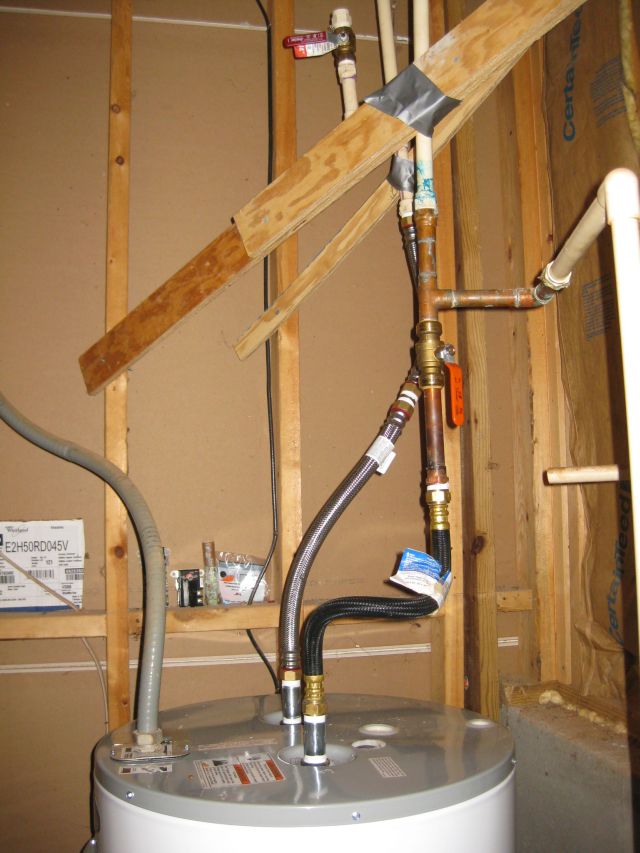New electric heater
The electric water heater in the basement began leaking water – a lot of water by the time I discovered what it was up to. Most of my neighbors in this rural area have propane tanks and use propane for water heating, cooking and warming their houses. My house has a heat pump for heating and cooling and uses electricity for cooking and water heating. This is one of the reasons I recently installed an efficient wood stove.
The electric water heater was corroded, and beyond repair so, after researching various brands I bought a new Whirlpool 50 gals 9 year warranty replacement from a big DIY store. Their website said the 12 year warranty model was in stock but on arrival I was told their website was not accurate (they really should get this fixed), so I bought the cheaper 9 year warranty version and saved $100 plus, and then trucked the heater home. The installation had two complications – the soldered in place gate valve was defective and the conduit had 4 wires and the heater required only 3.
Gate valves are good for controlling water flow but if you have to shut off the water completely a ball valve is the way to go. Soldering a new valve would have been time consuming since water kept dripping down the pipe which lead to the floors above. Also my soldering skills have become erratic. In London I soldered numerous copper connections with hardly any fails – here my success is mixed and I attribute this to my using Mapp gas which is too hot compared with propane, and perhaps to the old flux I was using. Note that, consistent with the saying “a bad workman always blames his tools” I exculpate myself. And in London the way I solved a dripping pipe was to push bread up the pipe and this detained the drops long enough for me to get the job done. Anyhow, I have been wanting to try out a “SharkBite” and this was my opportunity.
A SharkBite is a push fit connector (no soldering required) and I bought one which combined with a ball valve. It cost just less than $20 which is a lot for one connection. However I was staggered at the cost of the fittings I usually use – both big DIY outfits wanted over $6 for a 3/4″ female copper connector (come on!) and if I had bought this, plus 3 male connectors plus a ball valve the cost saving against the SharkBite would have small – and it would have taken longer, may not have taken and may have been a frustrating installation. The SharkBite worked perfectly and the plumbing was resolved.

I should explain some of the other features in the above photo. The new water heater is 48″ high compared with the old heater which was 60″ high. So I needed to extend the connections and opted for the flexible connectors shown rather than copper pipe – a more expensive alternative but easy to install and will save time on future replacements. At top left you can spot another ball valve in the off position. This is one of my innovations – a problem with well water is that if it is allowed to cool it can develop a stinky sulphur smell and the way to treat it is to add H2O2 (hydrogen peroxide) and also to not let the water cool. The top left valve is where I used to add the hydrogen peroxide – simply open the valve and drain half the water out the tank through the valve at the bottom of the tank, then with a plastic funnel add the peroxide through the top left valve. I haven’t had to do that for years since I now always keep the water at around 120 deg and the smell has not recurred. The wood battens are to secure the pipes against movement.
The second complication had to do with the wiring – both heaters required 240 volt service and the cable had 4 wires which had connected to various parts of the old heater, but the new heater only required 3 wires. I googled and learned that the 4 wires in the conduit consisted of 2 power wires, a neutral and a bare earth/ground. The new heater required the bare earth/ground to be connected to the body and had terminals for the two power wires. But what about the 4th wire which was neutral – surely that was needed, don’t you always have to have a neutral? Well apparently not – the 2 power wires produce the 240 volts and you only need the neutral if you have a 120 volt circuit, which a range has but not the new water heater. So I connected the three required wires, terminated the neutral and was done.
My first visit to a recycling yard
I loaded the old water heater into my ever so useful truck and, rather than go to the landfill where there is a $20 minimum charge, I visited a nearby (5 miles) metal recycling yard. I asked the office attendant if they accepted water heaters and the young girl said she had only been there a couple weeks and I should ask someone in the yard. I saw this old bod (my age) strolling towards me and he said he did not work there, had no idea, and had just finished helping his mate drop off some iron. I noticed that his mate had pulled the truck and trailer onto the truckscale/weighbridge. I found someone knowledgeable who said sure, so I returned to my truck and waited for the old bod and his mate to be paid. When they drove off the truckscale the driver stared at me very hard and I wondered what that was about. So I was weighed, then unloaded the heater then was weighed again and the attendant gave me a check for $14 since the heater weighed 140lbs and they paid $1 for each 10 lbs. It was only when I was driving away that I figured out the scam. The old bod sat with his buddy in the cab when they arrived and were weighed, then when the truck and trailer was being weighed after offloading the iron, the old bod was walking back from the dump to the office. So the truck was 150 lbs lighter, assuming that was his weight, and so they made an additional $15. I suppose if you are sneaky you could have also plugged the water heater and filled it with some water and this would also have increased the payout.
One of my running buddies just had his water heater replaced. Prior to the replacement he told me it would not cost him any since the heater was under warranty. When I next spoke to him he told me the cost was close to $1,000. His is a gas heater, he was not present when the work was done, and the repairman had solicitously asked his wife if they had grandchildren and upon learning they were proud grandparents, said that the flue connections were defective and leaking exhaust could cause serious harm to the grandkids and the defects should be fixed as soon as possible. My buddy who was hooked in to the call drew the line at paying $100 to have the old water heater removed and so I have volunteered to do this for him and will make another $14 and earn some goodwill along the way. He said that when I am older and no longer a DIYer and have grandkids I will be suckered just like him!
